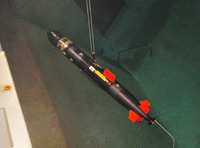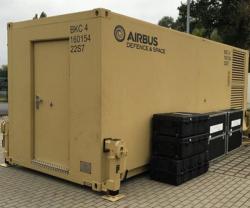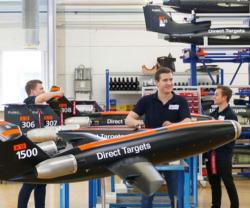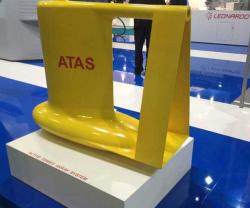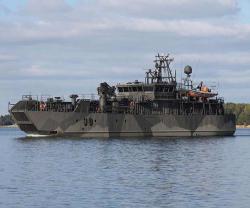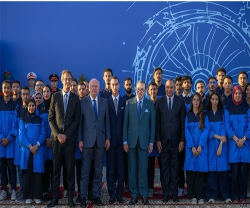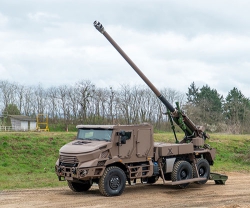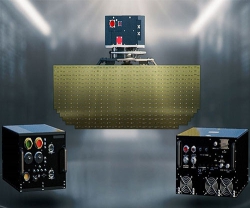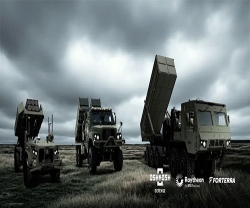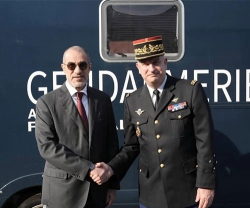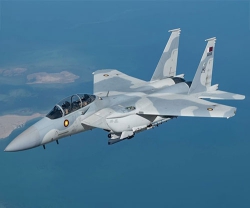World Première for ATLAS ELEKTRONIK’s SeaCat AUV
13.03.2012 North America
In a mission lasting almost 7 hours, an autonomous underwater vehicle made by ATLAS ELEKTRONIK “dived” through a water supply tunnel 24 kilometres long in the vicinity of Stuttgart (Germany) successfully investigating the tunnel for damage.
With this survey on 6 March 2012, it at last became possible to inspect the “Albstollen” tunnel in the State of Baden-Württemberg for the first time in 40 years.
The “SeaCat” underwater vehicle is produced by ATLAS ELEKTRONIK, a world leading manufacturer of marine electronics, such as sonars, submarine technology, mine warfare systems and Unmanned Underwater Vehicles (UUVs).
After a thorough disinfection, the craft was lowered into the inflow reservoir at Büttnau and guided into the tunnel by remote control. For the first 300 metres, the SeaCat was controlled through a laptop via a fibre-optic cable. After the vehicle had passed several obstacles in the first section, the cable was cut and the autonomous guidance system was activated to take control for the next 7 hours and 24 kilometres. The speed was about a metre per second, corresponding about 2 knots or 3.6 km/h.
Sven Hesse, Head of the UUV program at ATLAS, said after the mission: “Never before has a water-filled tunnel of this length been inspected by a diving robot navigating on its own. And rarely has such an entirely autonomous vehicle completed such a demanding task.”
Volker Paltzo and Dieter Rottsieper, Managing Directors of ATLAS ELEKTRONIK, commented: “We can certainly be proud of this achievement: it proves that ATLAS ELEKTRONIK is right on course to carve out a world leading role in this new field of technology.”
The “Albstollen” tunnel, with a length of 24 kilometres and a diameter von 2.25 metres, forms part of the water supply system operated by Bodensee-Wasserversorgung (BWV) with headquarters in Stuttgart. As the largest German long-distance water distribution systems, it provides fresh water from Lake Constance to 4 million people in 320 communities. As one of two main lines, the Albstollen passes through the Swabian Jura range to supply Stuttgart and the northern part of Baden-Württemberg.
Although the tunnel had been checked regularly in the course of its over 40-year lifetime through measurements of the hydraulic friction losses and through the leakage rate, a visual inspection of its condition over the entire length had not been technically possible until now.
As a leading German manufacturer of remote-controlled underwater vehicles, ATLAS ELEKTRONIK was therefore asked to inspect the water tunnel by means of an autonomous diving robot. Autonomous underwater vehicles (AUVs) are unmanned underwater vehicles (UUVs) that are not controlled via a cable, but are able to navigate entirely on their own.
The vehicle was tasked with recording video data over the total length of the tunnel, while moving continuously through the concrete tunnel and remaining centred with the aid of laser distance sensors. For the first time in 40 years, it became possible to look deep into the tunnel and to document its present condition.
The exit point of the trip after 24 kilometres was the shaft surge chamber at Talheim, a concrete structure comprising a shaft 38 metres deep and about 8 metres in diameter. This pressure-balancing well is normally half-filled with water. The water tunnel is routed through the well, forming a semi-circular channel at the bottom. A diver’s lamp was positioned at this point to provide a light indicating that the AUV had reached its final destination. This visual signal was detected by the vehicle, causing the autonomous guidance system to stop the vehicle and let it rise to the surface.
The SeaCat AUV is a torpedo-shaped underwater vehicle about 2.5 m in length and 30 cm in diameter. Being a hybrid vehicle, it can be operated either remotely controlled or fully autonomously with an endurance of up to 8 hours and a range of 40 km. Video cameras and a variety of sonars can be carried as the payload sensors. Typical areas of application include the inspection and mapping of inshore lakes, coastal sea areas, harbours, and marine structures such as dams or the foundations of wind turbines.
With this survey on 6 March 2012, it at last became possible to inspect the “Albstollen” tunnel in the State of Baden-Württemberg for the first time in 40 years.
The “SeaCat” underwater vehicle is produced by ATLAS ELEKTRONIK, a world leading manufacturer of marine electronics, such as sonars, submarine technology, mine warfare systems and Unmanned Underwater Vehicles (UUVs).
After a thorough disinfection, the craft was lowered into the inflow reservoir at Büttnau and guided into the tunnel by remote control. For the first 300 metres, the SeaCat was controlled through a laptop via a fibre-optic cable. After the vehicle had passed several obstacles in the first section, the cable was cut and the autonomous guidance system was activated to take control for the next 7 hours and 24 kilometres. The speed was about a metre per second, corresponding about 2 knots or 3.6 km/h.
Sven Hesse, Head of the UUV program at ATLAS, said after the mission: “Never before has a water-filled tunnel of this length been inspected by a diving robot navigating on its own. And rarely has such an entirely autonomous vehicle completed such a demanding task.”
Volker Paltzo and Dieter Rottsieper, Managing Directors of ATLAS ELEKTRONIK, commented: “We can certainly be proud of this achievement: it proves that ATLAS ELEKTRONIK is right on course to carve out a world leading role in this new field of technology.”
The “Albstollen” tunnel, with a length of 24 kilometres and a diameter von 2.25 metres, forms part of the water supply system operated by Bodensee-Wasserversorgung (BWV) with headquarters in Stuttgart. As the largest German long-distance water distribution systems, it provides fresh water from Lake Constance to 4 million people in 320 communities. As one of two main lines, the Albstollen passes through the Swabian Jura range to supply Stuttgart and the northern part of Baden-Württemberg.
Although the tunnel had been checked regularly in the course of its over 40-year lifetime through measurements of the hydraulic friction losses and through the leakage rate, a visual inspection of its condition over the entire length had not been technically possible until now.
As a leading German manufacturer of remote-controlled underwater vehicles, ATLAS ELEKTRONIK was therefore asked to inspect the water tunnel by means of an autonomous diving robot. Autonomous underwater vehicles (AUVs) are unmanned underwater vehicles (UUVs) that are not controlled via a cable, but are able to navigate entirely on their own.
The vehicle was tasked with recording video data over the total length of the tunnel, while moving continuously through the concrete tunnel and remaining centred with the aid of laser distance sensors. For the first time in 40 years, it became possible to look deep into the tunnel and to document its present condition.
The exit point of the trip after 24 kilometres was the shaft surge chamber at Talheim, a concrete structure comprising a shaft 38 metres deep and about 8 metres in diameter. This pressure-balancing well is normally half-filled with water. The water tunnel is routed through the well, forming a semi-circular channel at the bottom. A diver’s lamp was positioned at this point to provide a light indicating that the AUV had reached its final destination. This visual signal was detected by the vehicle, causing the autonomous guidance system to stop the vehicle and let it rise to the surface.
The SeaCat AUV is a torpedo-shaped underwater vehicle about 2.5 m in length and 30 cm in diameter. Being a hybrid vehicle, it can be operated either remotely controlled or fully autonomously with an endurance of up to 8 hours and a range of 40 km. Video cameras and a variety of sonars can be carried as the payload sensors. Typical areas of application include the inspection and mapping of inshore lakes, coastal sea areas, harbours, and marine structures such as dams or the foundations of wind turbines.
Previous PostBoeing at Satellite 2012
Latest news
Latest events
Dubai International Air Chiefs’ Conference (DIACC 2025)
16 Nov 2025Atlantis, The Palm Dubai - United Arab EmiratesDubai Airshow
17 - 21 Nov 2025Dubai World Central (DWC) - United Arab EmiratesEgypt Defence Expo (EDEX)
01 - 04 Dec 2025Egypt International Exhibition Center New Cairo - EgyptDoha International Maritime Defence Exhibition & Conference (DIMDEX 2026)
19 - 22 Jan 2026Doha - Qatar

